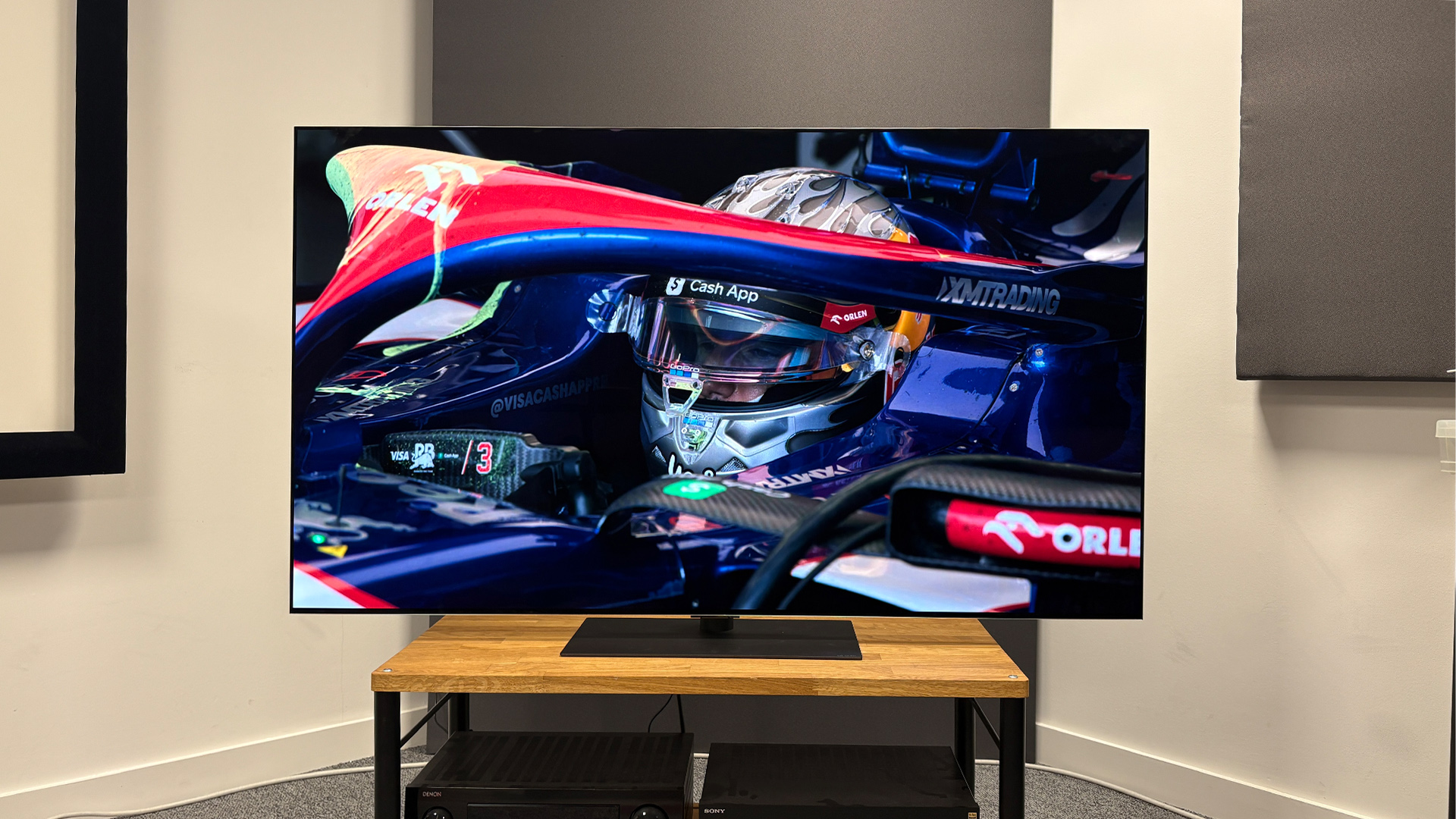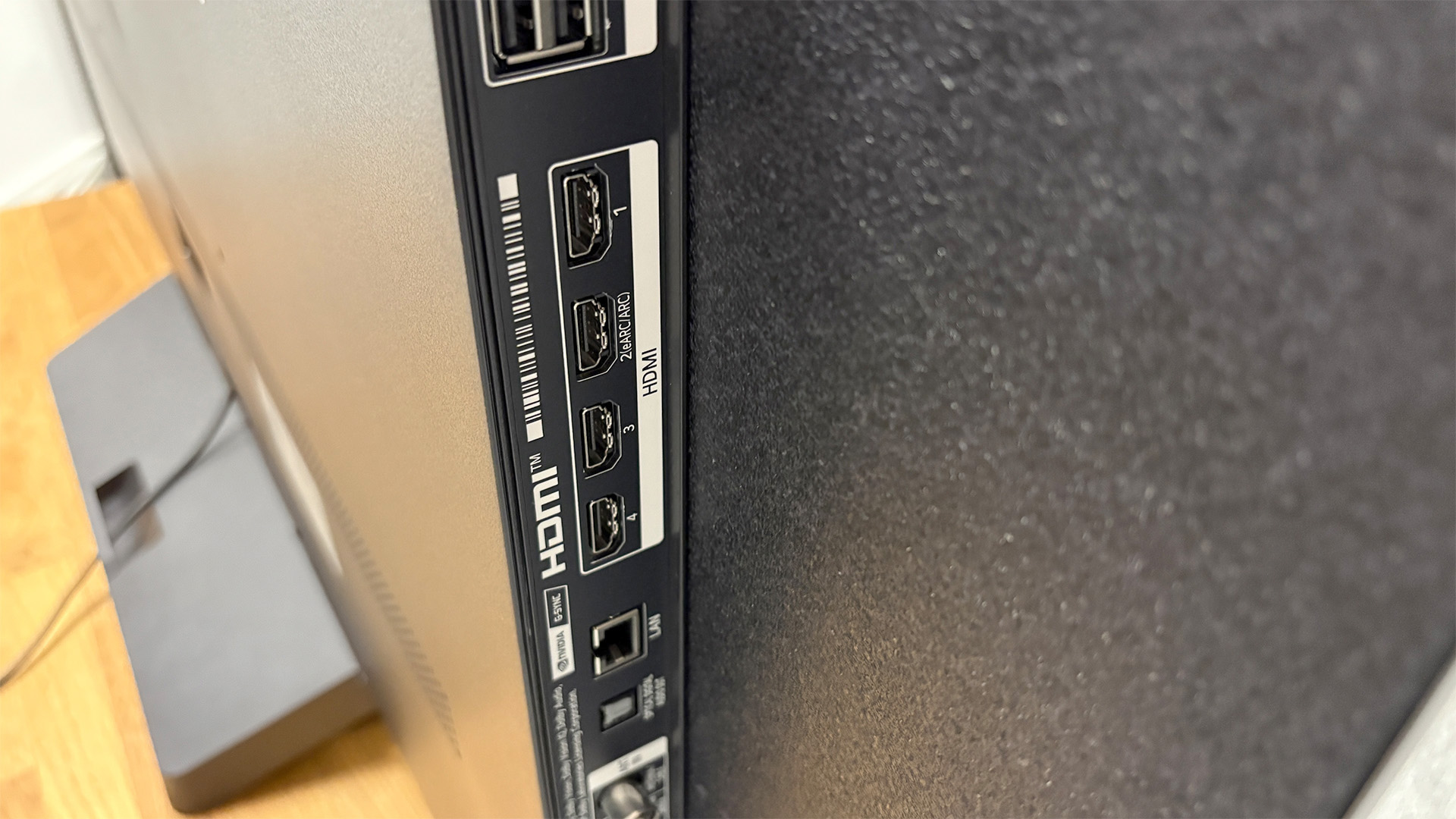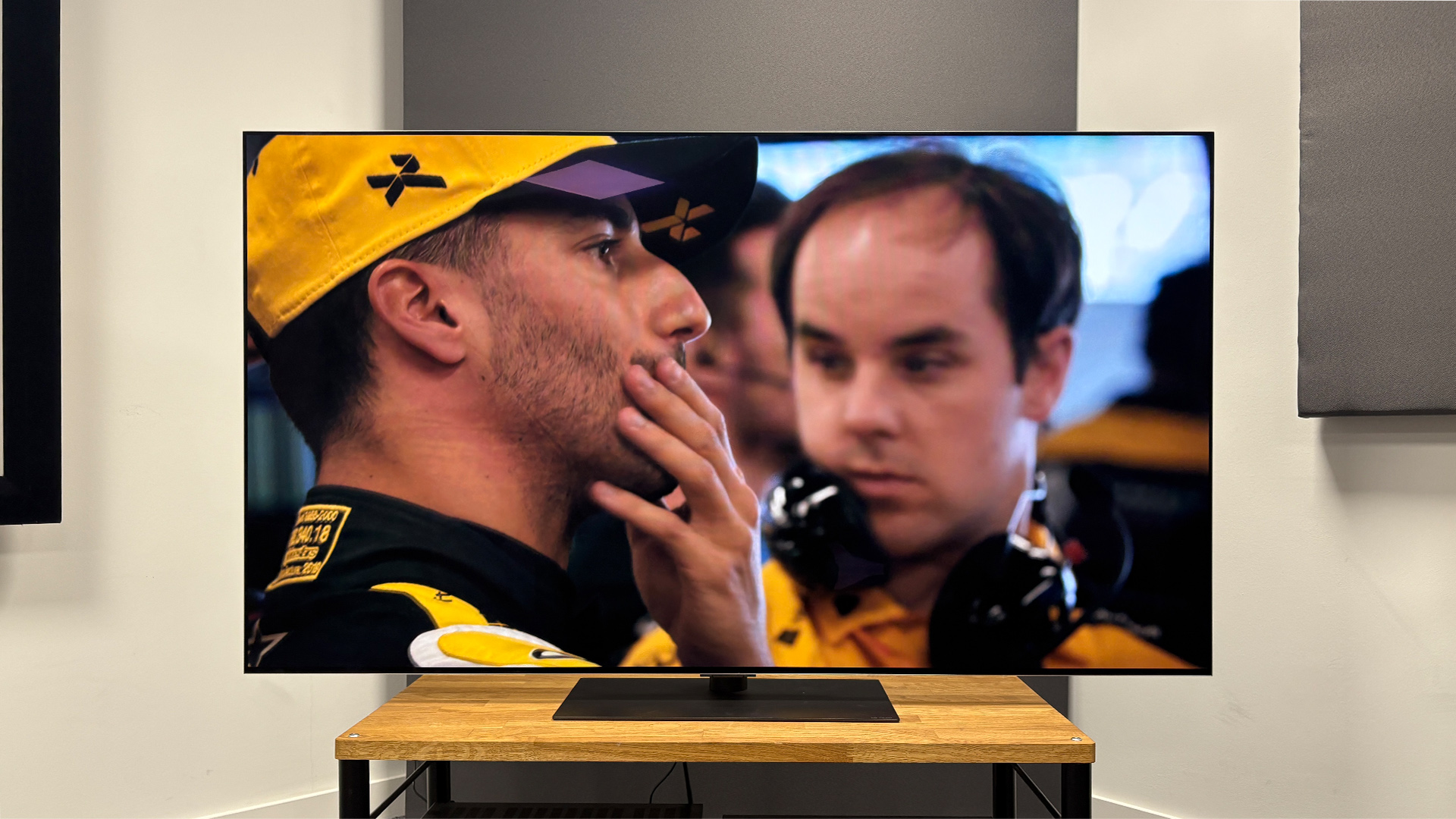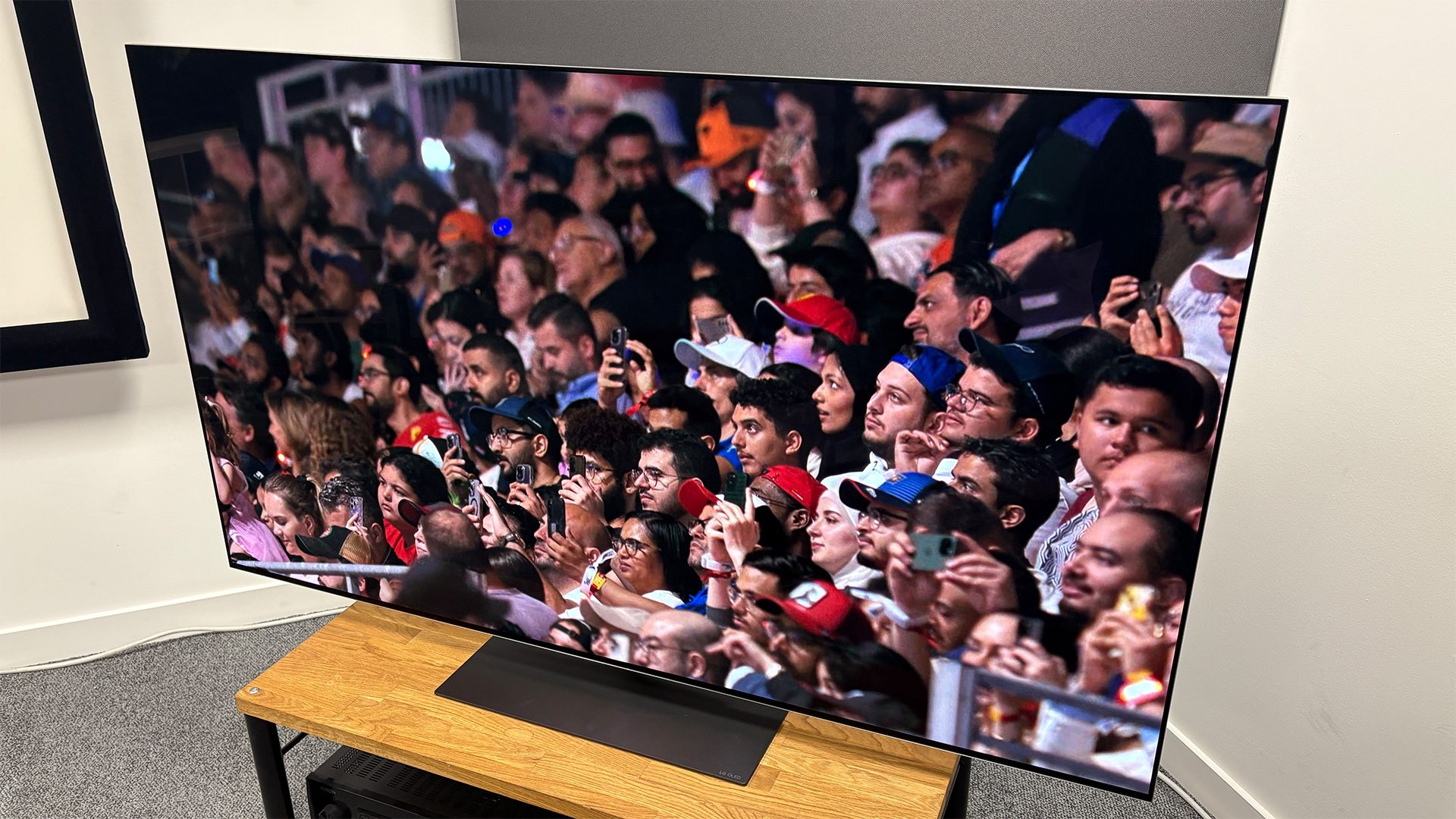
Screen sizes: 48, 55, 65, 77, 83 and 97 inches (65-inch model tested)
Type: OLED (Primary RGB Tandem)
HDR: HLG, HDR10, Dolby Vision
HDMI inputs: x4 (4 x 48Gbps HDMI 2.1)
Gaming features 4K/120Hz, 4K/165Hz, VRR, ALLM, Dolby Vision game mode, HGiG
The LG G5 is in most ways a stunning set – and a surprising leap forward for OLED TV technology. Unfortunately, there's currently a big problem with the way the TV handles streamed Dolby Vision. A fix is on the way, but right now the G5 should be avoided.
For
- Dazzlingly bright image
- Crisp and colourful picture
- Excellent feature set for gamers
Against
- Glaring Dolby Vision streaming issue
- Dull sound
Screen size: 42, 48, 55, 65, 77 and 83 inches (55-inch model tested)
Type: OLED (WOLED)
HDR: HLG, HDR10, Dolby Vision
HDMI inputs: x4 (4 x 48Gbps HDMI 2.1)
Gaming features 4K/120Hz, 4K/144Hz, VRR, ALLM, Dolby Vision game mode, HGiG
LG's latest C-series OLED is, contrary to its spec sheet, a surprisingly large upgrade on the C4. It can't go as bright and it isn't as generally spectacular as the next-gen G5, but it's incredibly accomplished for the money and all the TV that most people will need.
For
- Rich, solid and engaging picture that balances vibrancy and authenticity
- Excellent contrast and image solidity
- Uncompromising feature set
Against
- Sound is good rather than great
- Not as bright as Primary RGB Tandem or QD-OLED models
The LG C5 and G5 are the latest entrants in the long-running (and multi-Award-winning) C and G series of OLED TVs. The former is the more affordable of the two, while the latter offers a more premium spec and panel technology. And both are contenders for the best TVs to buy this year.
Wondering which is right for you? You've come to the right place. We've now put both the G5 and C5 through our rigorous testing processes, and can now provide detailed insights on their performance. So let's see how the two compare.
LG G5 vs C5: price
We now have official launch pricing for both the G5 and C5 models across various sizes, giving us a clear picture of how these premium OLED TVs are positioned in the market.
Here's how the pricing breaks down for the 2025 models:
As expected, the G5 commands a significant premium over the C5. Even with these prices, there is still hope for those on a tighter budget. LG's OLED TVs tend to see significant discounts later in the year, so if you can hold out, you could save a tidy sum.
The introduction of the 48-inch G5 also provides a new entry point into LG's premium OLED line, though it's worth remembering this size doesn't feature the new Primary RGB Tandem/Four-Stack OLED panel tech.
Regardless, the LG C5 has to take this round. As for whether or not the G5 is worth the extra cash? We'll get to that...
** Winner: LG C5 **
LG G5 vs C5: design

Place these models side by side with their predecessors, and you might struggle to spot the difference. But while not much has changed from their respective predecessors, the G5 and C5 are very different to one another.
The G5 has a 'Gallery' design, which means it looks a bit like a picture frame. But unlike G-series models of old, the G5 is offered in two versions: one with LG's Zero Gap wall mount, and the G5S variant, which includes a tabletop stand at the 55- and 65-inch sizes. You will also be able to buy a stand for the G5 separately as well.
The stand itself can be set to two positions – a sleek low-profile look, or a higher position that accommodates a soundbar underneath.
The C5 retains the supremely slender side profile across much of the chassis, with a modest boxout that houses the connections and processing components near the bottom of the rear panel. It's also incredibly lightweight by TV standards.
On the front of the TV, we're treated to slender bezels around the display and a narrow, central pedestal-style stand that is both stylish and slightly obstructive to those who wish to position soundbars below their TV, due to the fact it tapers outwards.
The G5 has a universal thickness of just 2.4cm, giving it a consistently slim profile compared to the C5's variable thickness.
Also, for the first time, the G series model comes in a 48-inch size, though it doesn't go quite as small as the C5, which comes in a 42-inch model. It's worth noting, however, that the 48-inch and 97-inch G5 variants don't feature the new Primary RGB Tandem OLED panel found in the other sizes.
The G5's tabletop stand is also swapped out for dual blade-style feet on the smallest model, while the largest version is bundled with a wider stand to accommodate the broader frame.
Ultimately, beauty is in the eye of the beholder and which of these two TVs is most visually appealing to you will probably come down to whether you're wall-mounting it or placing it on furniture.
However, to these eyes, the C5 is actually the more attractive TV, primarily on account of the incredibly thin sections of its chassis. Unlike the G5, all versions come with a stand (or feet), too, and its incredible lightness makes it easy to wall-mount.
** Winner: LG C5 **
LG G5 vs C5: features

The G5 has a couple of new tricks up its sleeve.
First up, LG has ditched the MLA screen technology of the G4 and switched to the new Primary RGB Tandem OLED panel technology (also known as Four Stack OLED).
This new panel architecture comprises four individual OLED layers – two blue, one red and one green – to boost brightness and colour volume. This results in even more brightness with more vibrant colours.
According to LG, the G5 is three times brighter than the brand's entry-level B5. It doesn't offer a brightness comparison with the C5, but the difference there is clear to see. We'll get to that in the picture section below.
The C5 has to make do with a standard WOLED panel. Not only does it not feature the fancy new four-stack brightness-boosting panel architecture of the G5; it doesn't even get the MLA technology of the old G4 or G3. Nor does it feature a heatsink.
Even so, LG has managed to squeeze some more brightness out of this panel for the C5. Again, more on that below.
Both TVs are exceptional for gaming, with all four HDMI sockets being full-fat, 48Gbps HDMI 2.1 affairs with support for the all-important 4K/120Hz, VRR and ALLM features.
Both models can in fact support 4K gaming signals beyond 120Hz, with the C5 going up to 144Hz and the G5 right up to 165Hz. For console gamers, all of this is irrelevant, as even the Xbox Series X and PS5 Pro max out at 120Hz, but it will be a consideration for super-hardcore PC gamers with equally hardcore rigs.
Both TVs have excellent HGiG implementation, which makes it a doddle to get a spectacular and accurate HDR performance from most modern games, and both support Dolby Vision gaming, too.
Of course, both TVs also support Dolby Vision for movies and TV shows, plus the standard HLG and HDR10 formats. No LG TVs support HDR10+, but we don't consider this to be a big deal.
Rather than all-new processors, both the G5 and C5 feature upgraded versions of last year's respective offerings. The G5 has the Alpha 11 AI Processor Gen 2, while the C5 has the Alpha 9 Gen 8. LG hasn't been clear on what improvements these bring, but it did say that the AI Picture Pro feature (which automatically improves the picture quality) has been enhanced.
The new processor in the G5 drives many of the AI-backed functions, including AI Picture Pro, which serves as an umbrella term for features such as AI Perceived Object Enhancer (which aims to enhance the three-dimensionality of the picture), AI Super Upscaling, and OLED Dynamic Tone Mapping.
The G4's Virtual 11.1.2-channel upmixing has also come to the C5, while the AI Sound Pro mode now has a Voice Remastering feature that intelligently boosts dialogue clarity without sacrificing the other elements of a soundtrack.
Both TVs will have three new features courtesy of LG's AI TV system: ‘Recognise You’, ‘Customise to You’ and ‘Care Around You’.
'Recognise You' uses voice recognition to detect which user is barking commands at it or asking it questions so it can respond correctly.
'Customise to You' lets the individual users customise the TV's picture and sound settings to their preference, and load them up each time they watch.
'Care Around You', meanwhile, helps you solve common issues using an AI chatbot.
The TVs also benefit from a large language model, meaning you can use natural commands such as "make the picture brighter" rather than having to remember specific phrases.
So, the G5 and C5 share an awful lot of features, but the Primary RGB Tandem OLED panel, faster processor and support for 4K/165Hz gaming mean this round has to go to the G5.
** Winner: LG G5 **
LG G5 vs C5: picture

Having now tested both the G5 and C5, we can provide detailed insights into their respective picture performances. The C5 offers a rich, dynamic, and detailed picture that impresses at every turn, with improved brightness over its predecessor. But the G5 takes things to another level entirely with its new panel technology.
The G5's Primary RGB Tandem OLED panel delivers truly dazzling brightness levels that can, in peak brightness highlights, literally make you want to shield your eyes. This is most noticeable in HDR content mastered for high brightness, such as 4K Blu-rays of The Matrix and Pan – both of which show off the G5's stunning highlights while maintaining excellent detail.
Colours on the G5 also benefit from the enhanced colour volume. The TV presents vibrant, rich hues alongside well-judged skin tones with a natural hint of warmth. The overall picture has a fantastic three-dimensional quality, with subjects standing out against backgrounds to striking effect.
Both TVs deliver excellent motion handling. They excel at presenting fast movement without judder or stutter when using the Cinematic Movement TruMotion setting. Even with motion processing turned off completely, both TVs still handle motion very well.
However, there is a significant issue with the G5 that prospective buyers should be aware of. Our testing revealed a flaw in how the TV handles streamed Dolby Vision content. When watching such content, particularly dark scenes suffer from blocky ripple effects, patchy areas, image noise, and greyish blacks instead of the deep blacks expected from OLED technology.
Interestingly, this problem doesn't affect Dolby Vision content played via 4K Blu-ray, nor does it appear with streamed HDR10 content.
LG is aware of the issue and has sent over a software update that appears to fix the issue, though it has yet to roll out to consumers and retail units. We plan to retest the G5 fully once the final version of the update has been rolled out to the public before reconsidering our G5 star rating.
Until then, this is a major problem for the G5. Most buyers watch most content via their TV's built-in apps, and the vast majority of the HDR content from those apps is in Dolby Vision, so the issue is highly unavoidable – and it renders some content almost unwatchable.
The C5 doesn't suffer from this issue, and while it doesn't have the pizzazz of the G5 at its best, it does offer a rich, dynamic, and detailed picture that still impresses at every turn.
When watching movies in Filmmaker Mode (now imbued with the power of Dolby Vision HDR for the relevant content), the C5 delivers an accurate and balanced picture. For HDR10 content, we highly recommend switching on dynamic tone mapping to experience the full brightness upgrade that the C5 offers.
The C5's colours are rich and punchy, too, and yet never look overdone or unnatural. Low-light colour volume is a particular strength, allowing dimly lit scenes to appear atmospherically dingy while still maintaining rich hues and colour variation. This extends to skin tones, which are presented with lively-looking warmth that makes all the difference.
The picture's solidity and three-dimensionality are also exceptional, with subjects standing out against backgrounds to striking effect. Edges are sharp yet never over-etched or artificial-looking.
The extra brightness over the C4 is most noticeable in high-nit content such as Pan, where the C5 presents scenes with stunning brightness and lavish colours. While it may not rival the highs of QD-OLED or the new Primary RGB Tandem OLED found in the G5, it's evident that LG has pushed the limits of 'traditional' OLED even further than before.
For Dolby Vision content, the C5 excels at low-light scenes. Colours remain punchy, and subtle lighting looks natural and effective. Dark details are well presented, allowing viewers to differentiate between different shades of black even in shadowy portions of scenes.
The C5's upscaling capabilities are equally impressive. When displaying HD and SDR content, the TV retains remarkable detail without introducing fuzziness or blockiness. The enhanced brightness is even apparent here, with intense light sources being replicated with the necessary impact.
Ultimately, though, everything the C5 does, the G5 does at least as well, if not better. That would make the G5 the clear winner in this round, but that problem with streamed Dolby Vision content is too big to ignore. So, for now, the C5 is the winner here.
** Winner: LG C5 **
LG G5 vs C5: sound

Having now tested both models thoroughly, we can confirm that neither the G5 nor the C5 offers particularly impressive sound quality. The G5 features a 60W 4.2 channel sound system, but despite the impressive specifications on paper, the performance doesn't quite deliver.
In our testing of the G5, we found that the Cinema sound preset offers the best performance, providing a wider, louder and punchier sound compared with the Standard setting. However, even in this mode, the TV struggles with dynamic shifts and doesn't dig particularly deep into the low end of bass-heavy soundtracks. Dialogue often sounds quite lifeless and lacks emotion, particularly in quieter scenes.
As for the C5, while it delivers dialogue with enough clarity for day-to-day use, the overall sound quality is merely adequate, rather than exceptional.
Voices have some warmth and presence to them and are outwardly projected enough to make them audible. There is a semblance of atmospheric effects, with background sounds coming across with decent detail, though upward-firing projection is limited, as height effects seem to stick to the top edge of the TV's chassis.
What's really missing, though, is a sense of low-end heft, as bass-heavy content feels lightweight. Increasing the volume can add some impact, but also introduces unwanted crackling.
The AI Sound mode doesn't shine either, as it introduces an aggressively harsh quality with an unpleasantly abrasive edge that makes dialogue and effects sound forced.
Ultimately, you'll want to pair either TV with one of the best soundbars to match their impressive picture quality.
** Winner: draw **
LG G5 vs C5: verdict

The C5 and G5 represent significant steps forward for LG's OLED lineup in 2025, each bringing distinctive advancements to the table. Having thoroughly tested both models, we can now provide a comprehensive assessment that accounts for the latest developments.
The C5 continues LG's tradition of excellence in its step-down OLED range, delivering rich, dynamic imagery with noticeably improved brightness over its predecessor. Its balanced performance across various content types, coupled with a comprehensive feature set and competitive pricing, reinforces its position as a benchmark in the OLED TV market.
The G5, however, marks a genuine technological leap forward with its Primary RGB Tandem OLED panel. This four-stack architecture delivers breathtaking brightness levels and colour volume that redefine what we thought possible from OLED technology.
If both TVs were currently performing flawlessly, we would have a tough time choosing between them once value was taken into account, but declaring a winner here is made much easier by the G5's problem with streamed Dolby Vision content.
That's such a big problem – and one that so many buyers will find impossible to avoid – that we just can't recommend the G5 to most people right now. So, at least for the time being, the C5 takes the win.
** Overall winner: LG C5 **
MORE:
Read our LG C5 review
LG 2025 OLED TV lineup: everything you need to know







